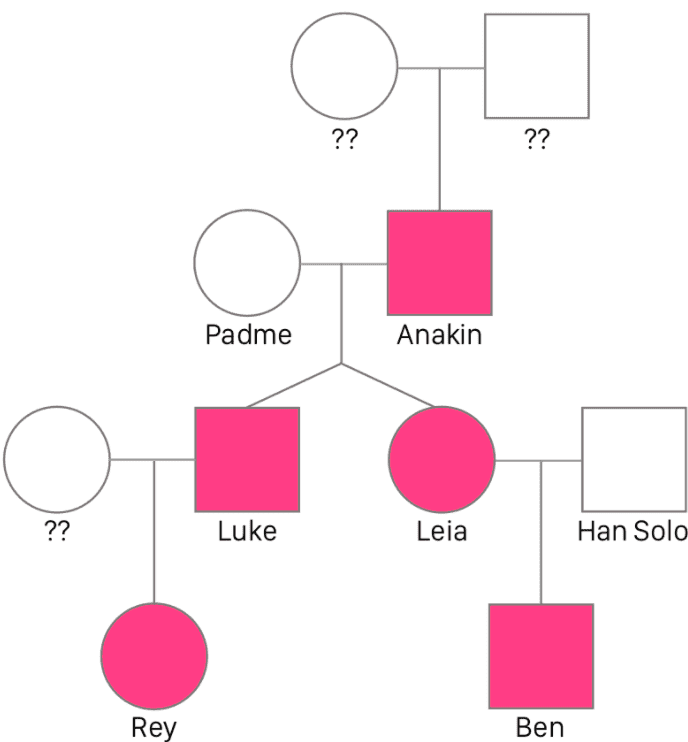Explaining inherited traits and family genomic studies with Star Wars

These aren’t the genes you’re looking for
Here at Helix, we have some self-proclaimed Star Wars geeks who revel in every new trailer and contemplate the mysteries of this galaxy far, far away. In the nail-biting space between The Force Awakens and The Last Jedi there are still many open questions and heated debates on what will happen next. Is Rey Luke’s daughter? Is that why she’s such a natural Force-user? And what is the mechanism of inheritance for her Force-sensitivity? In honor of May the Fourth we thought we’d take the opportunity to combine our love of both DNA and the Dagobah system to explain how we think inheritance of the Force works using our favorite Star Wars family as an example (don’t worry, no Bothans were harmed to bring you this information).
To start off, let’s look at how we determined if Force-sensitivity is genetic. Our approach here is similar to other family studies related to genetics. To determine whether a trait is heritable in human populations, it’s necessary to distinguish between genetic and environmental influences (how they were raised, stress, diet, and so on). This is because DNA is only one piece of your whole-health picture, and environmental factors also influence the phenotype (the set of observable characteristics of an individual). Ideally, experiments that try to determine whether a trait is genetic will look at identical twins raised apart, because they are genetically identical but environmentally different. For the Skywalkers, we don’t have identical twins to compare, but we do have multiple family members raised in isolation from one another, which gives us a clearer view into the genetic versus environmental influences on their Force-sensitivity.
Here’s what we know about the apparent inheritance pattern of Force-sensitivity in Skywalker scions: We don’t know who Anakin’s father was (we’d rather not talk about midichlorians) or who Rey’s parents really are. But we do know that Luke and Leia are fraternal twins, whose biological parents were Anakin Skywalker and Padme Amidala. Anakin was highly Force-sensitive, as were his son Luke, and his grandson, Ben Solo. We’re told by Luke that Leia is also Force-sensitive, and Obi-wan and Yoda also refer to her as an alternate hope for a Jedi if Luke was to fail (meaning they see her potential for Force-sensitivity too). We also know that she can feel disturbances in the Force. Rey is also highly Force-sensitive (and for the purposes of this article, let’s just assume that she’s Luke’s daughter).
Taking all of this into consideration, we have theorized that based on the lineage of the Skywalker-Solo clan, there’s abundant evidence that Force-sensitivity is genetic. This is due to the similarity in traits between Skywalker family members raised in isolation from one another, and in totally separate environments (with the exception of Ben Solo who was raised with his mother and trained by his uncle). Luke and Leia grew up on entirely different planets. Neither knew their father (until later in life), and Leia was raised as galactic rebel royalty, whereas Luke was a simple moisture farmer bullseyeing womp rats in his T-16. Rey was a scavenger from childhood, when she was left behind on Jakku by her family. They all had physical and socio-economic differences in their upbringings. Not only do they all display high levels of Force-sensitivity, but a keen self development of using the Force, even at a mature age that is atypical for normal force users. Yoda observes in both Anakin and Luke that they are too old to train as Jedis, and yet both make considerable gains in their skills and abilities as Force-users. This is an argument for Rey being Luke’s offspring as well; without any training (that we know of) she is able to learn to manipulate the Force for mind tricks and quickly adopts the lightsaber (ahem, Luke’s lightsaber) as a weapon of choice.
Theory 1: The Force is inherited through a de novo autosomal dominant mutation
Our scientists debated a few theories. One is that the Force is inherited in an autosomal dominant fashion. Autosomal dominant inheritance is just one of several ways that a trait can be passed from parents to children. Dominant means that if you inherit the gene from either parent, you will exhibit the traits of it, and autosomal means that it’s inherited with the same pattern in men and women. This is different than a recessive gene, that requires both parents to pass on the gene in order for it to manifest. You can track autosomal dominant mutations through families — parents pass them to their kids who pass them onto their kids. In this way, you see the trait in every single generation, just like the Skywalker clan. Anakin passed the force-sensitive gene to Luke and Leia, who then passed it onto their children (regardless of the apparent lack of Force-sensitivity in both Queen Amidala and that scruffy-looking nerf herder, Han Solo).

Both our theories of Force inheritance can explain the pattern of force sensitivity in the Skywalker family.
But wait! How did Anakin inherit the force? Based on what we know, it doesn’t seem likely that Anakin inherited the force from his parents. So does that throw our autosomal dominant theory out the window? Nope. It’s possible that Anakin had a de novo force sensitive mutation. A de novo mutation is a gene variant that is present for the first time in a single individual as a result of a DNA change in a germ cell (egg or sperm) of one of the parents or in the fertilized egg itself. The de novo mutation in Anakin would then have been autosomal dominant, that he then passed on to his children, and they to theirs. So, it seems like the autosomal dominant inheritance pattern does fit the Skywalker family.
Theory 2: The Force is inherited through trinucleotide repeat expansion
Another theory to explain the sudden appearance of force sensitivity in Anakin is genetic anticipation, or trinucleotide repeat expansion (that’s more of a mouthful than Jabba’s tongue). It’s a special type of mutation in a gene that can look like a de novo mutation. In order to explain trinucleotide repeats, it’s important to understand how DNA is constructed. DNA is made up of four base pairs (A, C, T, G) and these pairs come together to build proteins. Specific sequences of these pairs that come together to build specific proteins are called genes. Some parts of DNA are repetitive and can have repeating units of different lengths (like ATAT or ACGACG). Because it’s repetitive, these sections of DNA can expand or contract due to slipping errors during DNA replication. In simple terms, if a gene is a combination of the bases ACG repeated four times (ACGACGACGACG), an expansion would mean that something occurs that makes that gene repeat ACG eight times instead (ACGACGACGACGACGACGACGACG). The result is a change in the resulting protein which can have function-altering effects. In some cases, the repeats continue to expand with each generation. When the repeat gets above a threshold, let’s say 12 for this example, you see the trait appear seemingly out of nowhere. So, Anakin’s mom may have had a sub-threshold repeat number, but it expanded in Anakin to above 12 and it appeared as if he had suddenly inherited the Force. He would also have then passed 12 repeats on to his children and they also inherited the Force-sensitive trait.
For now, the debate about which inheritance pattern fits the Star Wars saga best will rage on at Helix. What we can agree on is that we certainly see a strong correlation between family members, even those who were raised in different environments. So, which genetic inheritance pattern do you think explains the Force-sensitivity the best?
While we hope that using Star Wars as a way to explain some complex genetic concepts related to inheritance is both helpful and entertaining, we want to emphasize that the examples here are entirely fictional. The force, sadly, is not real nor are the characters described. For more information on heritability and genetics as it relates to disease, please visit https://ghr.nlm.nih.gov/primer/inheritance/inheritancepatterns.